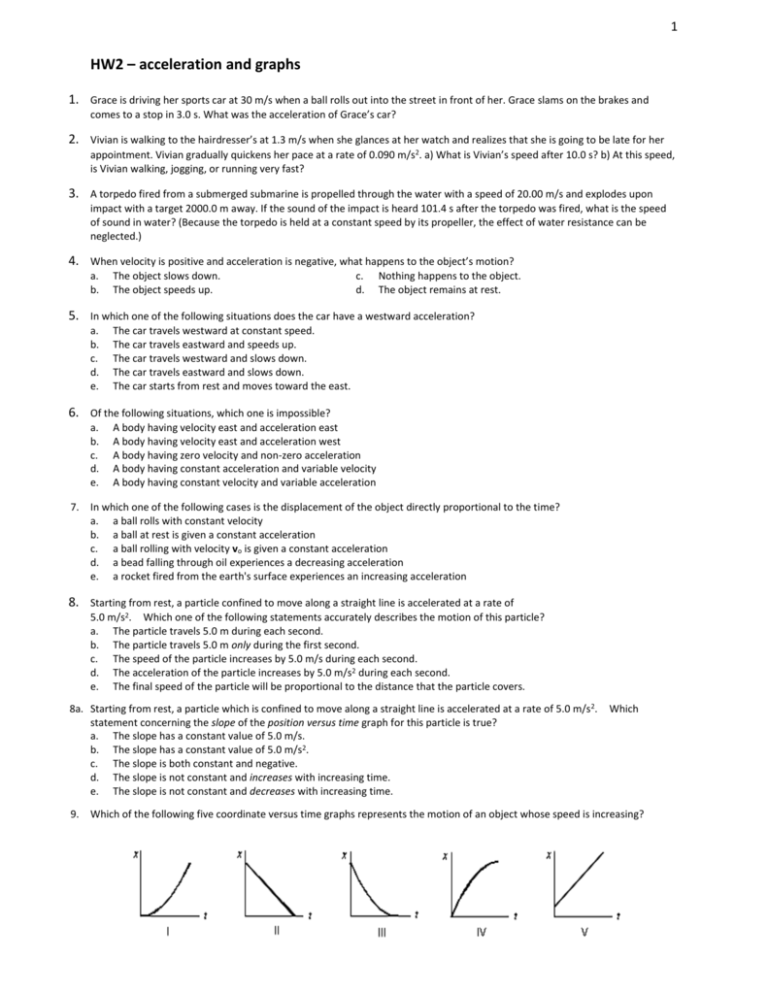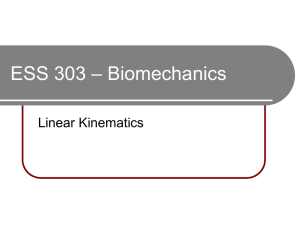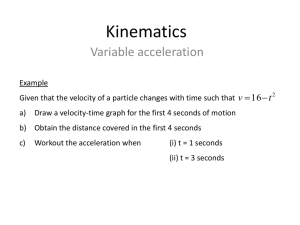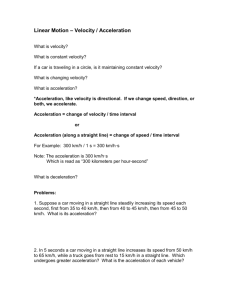HW2 – acceleration and graphs
advertisement

1 HW2 – acceleration and graphs 1. Grace is driving her sports car at 30 m/s when a ball rolls out into the street in front of her. Grace slams on the brakes and comes to a stop in 3.0 s. What was the acceleration of Grace’s car? 2. Vivian is walking to the hairdresser’s at 1.3 m/s when she glances at her watch and realizes that she is going to be late for her appointment. Vivian gradually quickens her pace at a rate of 0.090 m/s2. a) What is Vivian’s speed after 10.0 s? b) At this speed, is Vivian walking, jogging, or running very fast? 3. A torpedo fired from a submerged submarine is propelled through the water with a speed of 20.00 m/s and explodes upon impact with a target 2000.0 m away. If the sound of the impact is heard 101.4 s after the torpedo was fired, what is the speed of sound in water? (Because the torpedo is held at a constant speed by its propeller, the effect of water resistance can be neglected.) 4. When velocity is positive and acceleration is negative, what happens to the object’s motion? a. b. The object slows down. The object speeds up. c. d. Nothing happens to the object. The object remains at rest. 5. In which one of the following situations does the car have a westward acceleration? a. b. c. d. e. The car travels westward at constant speed. The car travels eastward and speeds up. The car travels westward and slows down. The car travels eastward and slows down. The car starts from rest and moves toward the east. 6. Of the following situations, which one is impossible? a. b. c. d. e. 7. A body having velocity east and acceleration east A body having velocity east and acceleration west A body having zero velocity and non-zero acceleration A body having constant acceleration and variable velocity A body having constant velocity and variable acceleration In which one of the following cases is the displacement of the object directly proportional to the time? a. a ball rolls with constant velocity b. a ball at rest is given a constant acceleration c. a ball rolling with velocity vo is given a constant acceleration d. a bead falling through oil experiences a decreasing acceleration e. a rocket fired from the earth's surface experiences an increasing acceleration 8. Starting from rest, a particle confined to move along a straight line is accelerated at a rate of 5.0 m/s2. Which one of the following statements accurately describes the motion of this particle? a. The particle travels 5.0 m during each second. b. The particle travels 5.0 m only during the first second. c. The speed of the particle increases by 5.0 m/s during each second. d. The acceleration of the particle increases by 5.0 m/s2 during each second. e. The final speed of the particle will be proportional to the distance that the particle covers. 8a. Starting from rest, a particle which is confined to move along a straight line is accelerated at a rate of 5.0 m/s2. statement concerning the slope of the position versus time graph for this particle is true? a. The slope has a constant value of 5.0 m/s. b. The slope has a constant value of 5.0 m/s2. c. The slope is both constant and negative. d. The slope is not constant and increases with increasing time. e. The slope is not constant and decreases with increasing time. 9. Which Which of the following five coordinate versus time graphs represents the motion of an object whose speed is increasing? 2 10. A car accelerates from rest on a straight road. A short time later, the car decelerates to a stop and then returns to its original position in a similar manner. Which of the five following graphs best describes the motion? 11. The graph represents the straight line motion of a car. How far does the car travel between t = 2 seconds and t = 5 seconds? a. 4m b. 12 m c. 24 m d. 36 m e. 60 m 12. An object moving in a straight line according to the velocity - time graph has an initial displacement of 8.00 m. (a) What is the displacement after 8.00 s? (b) What is the displacement after 12.0 s? (c) What is the average speed and average velocity for this motion? 13. Find the displacement - time graph for an object moving in a straight line according to the velocity - time graph. The displacement is initially zero. You do not have to put any numbers on the axes. 14. A mass has an initial velocity of 10.0 m/s. It moves with acceleration - 2.00 m/s2 . When will it have zero velocity? 3 15. What is the displacement after 10.0 s of a mass whose initial velocity is 2.00 m/s and moves with acceleration a = 4.00 m/s2 ? 16. A car has an initial velocity of 5.0 m/s . When its displacement increases by 20.0 m, its velocity becomes 7.0 m/s. What is the acceleration? 17. A body has initial velocity of 4.0 m/s and a velocity of v = 12 m/s after 6.0 s. What displacement did the body cover in the 6.0 s? 18. The car accelerate from rest to 28 m/s in 9.0 s. What distance does it travel? 19. A body has initial velocity of 12 m/s and is brought to rest over a distance of 45 m. What is the acceleration of the body? 20. What deceleration does a passenger of a car experience if his car, which is moving at 100.0 km/h, hits a wall and is brought to rest in 0.1000 s? Express the answer in m/s2 . 21. A car is travelling at 40.0 m/s. The driver sees an emergency ahead and 0.50 s later slams on the brakes. The acceleration of the car is - 4 m/s2. (a) What distance will the car travel before it stops? (b) If the driver was able to apply the brakes instantaneously without a reaction time, over what distance would the car stop? (c) Calculate the differnce in your answer to (a) and (b). (d) Assume now that the car was travelling at 30.0 m/s instead. Without performing any calculations, would the answer to (c) now be less than, equal to or larger than before? Explain your answer. 4 22. Figure shows the displacement versus time of an object moving in a straight line. Four points on this graph have been selected. (a) Is the velocity between A and B positive, zero or negative? (b) What can you say about the velocity between B and C? (c) Is the acceleration between A and B positive, zero or negative? (d) Is the acceleration between C and D positive, zero or negative? 23. Find acceleration of the object at time t = 6 s. Sketch graph acceleration versus time for the object. 24. Figure shows the variation of the displacement of a moving object with time. Draw the graph showing the variation of the velocity of the object with time. 25. The figure shows the variation of the displacement of a moving object with time. Draw the graph showing the variation of the velocity of the object with time. 5 26. The figure shows the variation of the displacement of a moving object with time. Draw the graph showing the variation of the velocity of the object with time. 27. The figure shows the variation of the displacement of a moving object with time. Draw the graph showing the variation of the velocity of the object with time. 28. The figure shows the variation of the displacement of a moving object with time. Draw the graph showing the variation of the velocity of the object with time. 29. The figure shows the variation of the velocity of a moving object with time. Draw the graph showing the variation of the displacement of the object with time. 6 30. The figure shows the variation of the velocity of a moving object with time. Draw the graph showing the variation of the displacement of the object with time. 31. The figure shows the variation of the velocity of a moving object with time. Draw the graph showing the variation of the displacement of the object with time (assuming a zero initial displacement) 32. The figure shows the variation of the velocity of a moving object with time. Draw the graph showing the variation of the acceleration of the object with time. 7 HW - acceleration and graphs Answer Section 1. vi = 30 m/s a v v f vf = 0 m/s i d3 a. 3. Torpedo: t = d/v = 100.0 s Therefore, the travel time for the sound is Sound: v = d/t = 1430 m/s = 1400m/s 12. vf = vi +at = 2.2 m/s A 5. D (a) 88 m 6. E 7. A 8. C (b) 68 m 19. 101.4 s – 100.0 s = 1.4 s 8a. D (a) negative (b) 10. E (c) 11. D (d) velocity = 5.0 m/s 16. a = 0.60 m/s2 19. - 1.6 m/s2 zero 9. A (c) speed = 8.33 m/s 17.x = 48 m 18. 126 m 20. 278 m/s2 21. (a) 220m 22. = 10.0 m/s a = ? b. jogging 14.t = 5.00 s 15. x = 220 m 13. v3 a = (0 m/s – 30 m/s)/(3.0 s) = - 10 m/s2 t 2. 4. = 1700. m (b) positive 200m (d) (c) 20 m (d) less positive 23. at t = 6 s a = 10/15 a = 0.67 m/s2 In addition to that, from graph you can see that a = 0 at time t = 13 s. 24. 25. 8 26. 27. 29. 31. 28. 30. 32.









